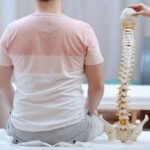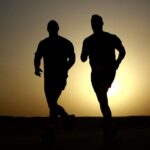Scoliosis is a disorder in which the spine curves sideways and can be found in adolescents and adults. Scoliosis can cause pain, discomfort, difficulties with breathing, sleep issues, and even more severe heart failure problems or sudden death.
Scoliosis is denoted by an S or C-shaped curve in the spine. You can observe it from childhood, but sometimes it can be seen in adulthood. Many reasons and conditions can cause scoliosis in adults. Some are genetics, uneven pelvic placement, spinal or joint surgery in the past, knee or foot distortions, or head injuries. The curves are not the same for everyone; some are deeper. From moderate to severe cases, they can be treated through surgery. In case you suspect scoliosis, you should see a doctor to know an appropriate treatment plan.
Chiropractors recommend people with scoliosis some exercises and stretching routines to help them improve dexterity. The difference between a spine and an individual with scoliosis is a typical spine can move from side to side. When walking, your spine bends and rotates left and right, and then it reverts to the center. It will be difficult for people with scoliosis to move in one direction due to their spine’s curvature.
Doctors and researchers have created several programs for scoliosis. The Scientific Exercises Approach to Scoliosis (SEAS) is a personalized program that helps people correct movement problems and changes their spine position. The proper exercise program will depend on the degree of scoliosis. If there is a specific exercise program that the doctor recommends, ask if it is alright to do other home exercises and an exercise you have to avoid.
What is scoliosis?

Scoliosis is a condition that causes the spine or backbone to have an abnormal curve. The normal range takes an elongated S form when looking from the side, the upper back bending outward and the lower back arching slightly. But when looking from the front, the spine will appear straight. From the side, the curve in the range that can be seen that is bent forward is called Kyphosis.
The normal Kyphosis is located in the middle spine. The curve that can be seen from the side where it is bent backward is called Lordosis. The normal Lordosis can be found in the upper spine and the lower spine or lumbar. People with scoliosis may develop another curve to either side of their bodies. The bones of the spine can form a C or an S-shaped in the spine. The scoliosis level ranges from 10-20 for mild, 20-50 for moderate and severe scoliosis is more than 50 degrees.
Scoliosis is more common among girls than boys. It can occur at any age but most common in those over ten years old. About 3% of adolescents have scoliosis. It is hereditary as individuals with scoliosis are more likely to have children with scoliosis. However, the severity of the condition may differ from one generation to the next.
Scoliosis is mostly mild, but some curves in the spine get more severe as the children grow. Severe scoliosis may lead to disablement and may reduce the amount of space within the chest, where the lungs won’t work correctly.
Children who have mild scoliosis are monitored strictly to ensure the curve is not getting worse with x-rays. Most cases do not need treatment, but some children have to wear braces to prevent the curve from worsening or straighten scoliosis.
Signs and Symptoms of Scoliosis

- Uneven shoulders
- The shoulder blade is more noticeable than the other
- Uneven waist
- One hip higher than the other
If scoliosis gets worse, the spine will also rotate or twist and curve side to side. So the ribs on one side may stick out yonder than the other side.
Stretches and Exercises for Scoliosis
Scoliosis makes the spine curve abnormal, causing discomfort, weakness, and the way a person walks. Among the essential parts of treatment are exercise and stretching.
The right exercises depend on the location of the scoliosis curve. People who have lumbar scoliosis must focus on exercising their lower back, and those with thoracic scoliosis must exercise their shoulders. Most doctors recommend these exercises and stretches.
- Pelvic tilts

A pelvic tilt exercise can help in stretching tight muscles in the hips and lower back. The pelvic tilt is done by:
- Lying on your back with your feet flat on the floor while bending your knees.
- Tightening your stomach muscles while lying your back flat on the floor.
- Hold for 5 seconds, and breathe normally.
- Release.
- Do this twice or in 2 sets.
- Raise the Arms and Legs

- Raising the arms and legs can strengthen the lower back.
- Lie on your front with your forehead on the ground.
- Extend your arms out over your head and your palms flat on the floor while keeping your legs upright.
- Raise one arm off the ground.
- Hold your breath and lower your arm back down.
- Repeat the process for each component and portion.
- Please do it for 15 repetitions for each element and leg.
- Cat-Camel

Cat-camel is one of the yoga poses that can support and maintain the spine supple but pain free. To do it,
- Start from your hands and knees. Make sure your back is in line with both your head and neck are relaxed.
- Arch your back, take a deep breath and draw your abdominal muscles in and up.
- Exhale and release your abdominal muscles while dropping the back and making the abdomen fall. Lift your head toward the ceiling.
- Do two sets of 10.
- Bird-dog

The bird-dog is another yoga pose. Do it by,
- Straighten your back with your hands and knees.
- Put your hands straight on your shoulders, with your knees directly under your hips.
- Stretch one arm straight forward, while the opposite leg is extended now at the back.
- Take a normal breath and hold for 5 seconds.
- Repeat with the opposite arm and leg.
- Do it for 10-15 repetitions for each side.
- Latissimus dorsi stretch

The latissimus dorsi is the largest muscle in the upper body that you can stretch. Thoracic scoliosis changes these muscles, and lumbar scoliosis can also create back problems that extend to the latissimus dorsi.
- Stand with good posture in a neutral position.
- Keep the feet apart and the knees slightly bent.
- Put both your hands over your head while grabbing your wrist with your left hand.
- It tilts slightly to the right side until you feel a stretch in the left side of your body.
- Hold for one to two breaths and push the left foot to return to the original position.
- Repeat on the opposite side.
- Do 5-10 repetitions on each side.
- Abdominal press

A strong abdominal muscle can help take some back muscle pressure, assisting a person in keeping a good posture. Do the abdominal press by:
- Lying on your back with your feet flat on the ground and bend your knees.
- Keeping your back in a neutral position.
- Raise both your legs off the floor at a 90-degree angle.
- You are working with your abdominal muscles using your hands to push down on your knees while pulling them toward your hands simultaneously. This is a static exercise, which means the legs and arms must not move when you are pressing.
- Holding three full breaths, and then you relax.
- Do two repetitions of 10
- Practice Good Posture

Having a good posture will lessen pain and muscle tension. Realigning the body several times a day can help a person to stand with a naturally good posture. A good standing posture is:
- Dropping your shoulders down and back.
- You Position your ears over your shoulders.
- You tuck your chin in so that it is not extending ahead or too far down.
- You draw your stomach slightly.
- You are somewhat unlocking your knees.
When sitting down, you have to keep your back straight and ears over your shoulders. Maintain a neutral position for your legs and must not be crossed.
Exercises to Avoid

Some activities and exercises can make the symptoms worse or even increase the risk of further injuries. Hence, people with scoliosis should avoid these activities:
- Keeping the neck bent forward where the head faces down, especially when using the phone.
- Playing football or high-contact sports can be dangerous to individuals with scoliosis.
- Ballet and gymnastics can injure the thoracic spine.
- Extending the torso repeatedly during yoga, ballet, or gymnastics maneuvers.
- Exposing the range to jumping or running impacts.
Complications

Although some people have a mild form of scoliosis, it may sometimes cause serious
complications.
- Lung and heart damage. Due to the rib cage crushing against the lungs and heart, it will be painful to breathe, and the soul will have a hard time pumping.
- Back problems. Adults who have scoliosis may develop chronic back pain.
- Appearance. As scoliosis worsens, it may lead to uneven hips and shoulders, protruding ribs, and the waist and truck’s dislocation to the side. It may result in the individual being more self-conscious of their appearance.
Conclusion

Specific exercises and stretches can help people treat mild cases of scoliosis, disregarding the need for surgery. Although research has proven specific exercises for scoliosis, there are some activities that people with scoliosis may have to avoid.
It would be the best idea to speak to a chiropractor about the best stretches and exercises to work for a specific scoliosis case.








